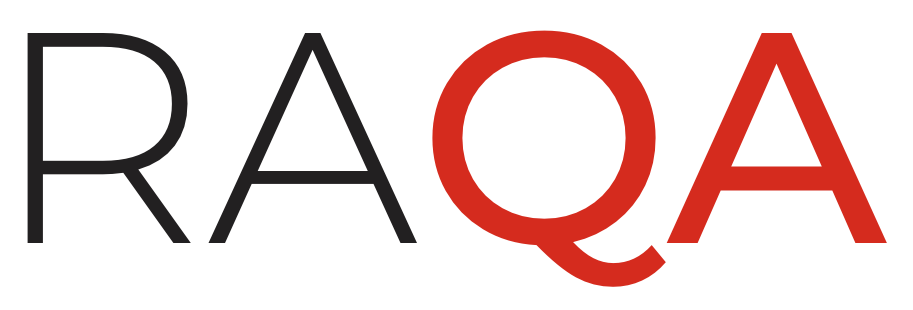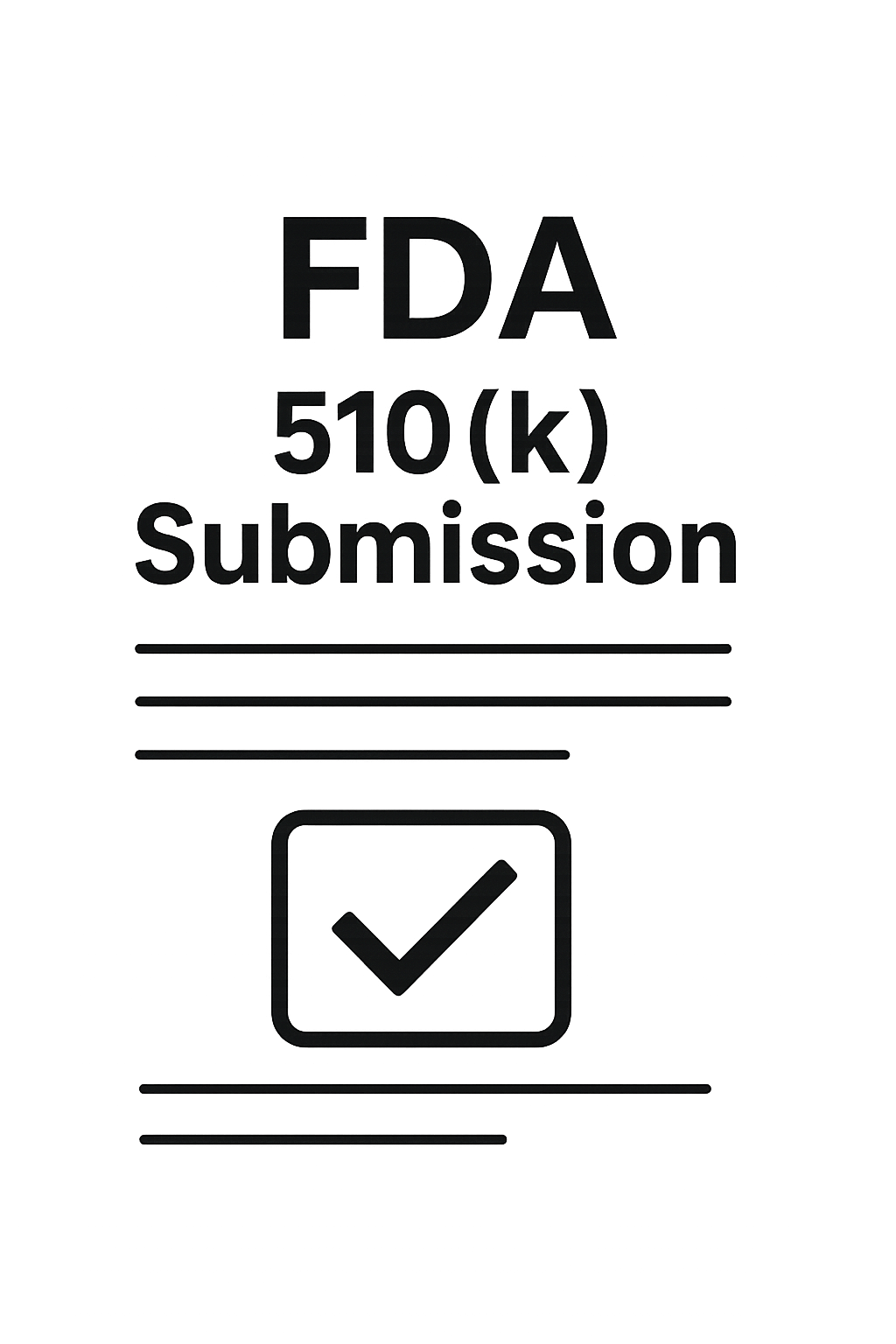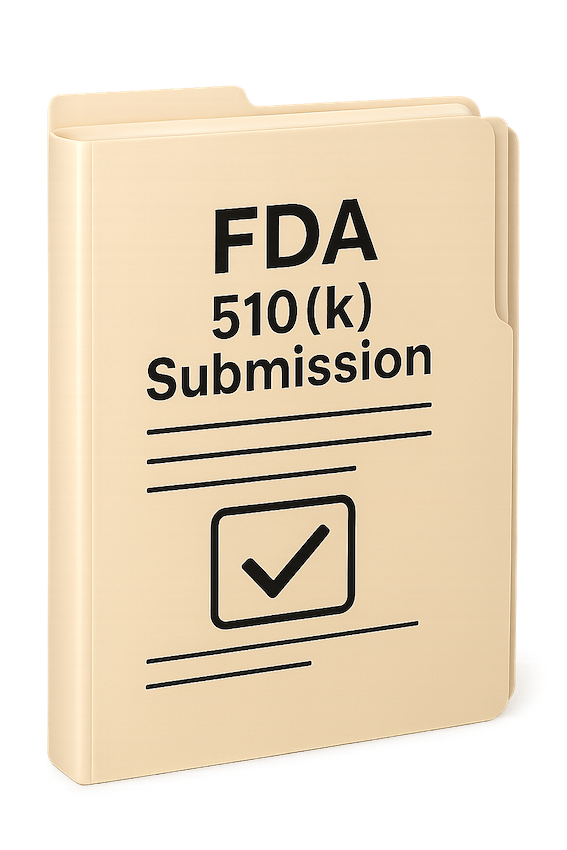Food, Drug & Cosmetic Act, Section 510(k)
FDA 510(k) Premarket Notification (PMN)
RAQA has successfully aided with the FDA 510(k) applications for diverse medical device manufacturers worldwide. However, please note that a Premarket notification under Section 510(k) is the beginning of your medical device. Once you receive a substantially equivalent (SE) letter, you must comply with the Quality System Regulations (QSR) or the new Quality Management System Regulation (QMSR), which aligns closer to ISO 13485.


FDA 510(k) Premarket Notification (PMN) under Food, Drug & Cosmetic Act (The Act), Section 510(k)

FDA REGULATORY SUBMISSIONS
The FDA 510(k) is a clearance or premarket notification. The Food, Drug, and Cosmetic Act, Section 510(k) requires device manufacturers to submit a notice to the FDA 90 days before they intend to market a medical device. It is also called 510(k) Clearances, Substantially Equivalent Letter (or SE Letter), or Premarket Notification (PMN). It must not be confused with premarket approval (PMA) under Section 515.
Predicate Device & FDA 510(k) PMN
For new medical devices marketed after 1976, under the Medical Device Amendments to the FD&C Act of 1976, manufacturers must submit a premarket approval under Section 515. However, legally marketed devices before May 28, 1976, are known as a “predicate” or “preamendments device.” These legally marketed devices do not require 510(k) submission or a PMA under Section 515. Therefore, if your device is substantially equivalent (SE) to one of those predicate devices, you can submit a clearance request under Section 510(k).
For some low-risk devices, the FDA may reclassify them to the list of 510(k) exempted devices. The list is updated periodically, so check if your device is also 510(k) exempted.
Even though FDA 510(k) submission is required 90 days before your intent to market your device, it may take longer than 90 days to get a clearance letter from the FDA. Therefore, you may want to plan and submit early. Sometimes it takes less than 90 days, but it could take much longer. Also, there is no form or template for submitting a notification.
You don’t want to assign anyone for this critical submission part.
Many consultants out there with some training or experience can prepare a 510(k) application. However, you must be cautious about whatever you submit to the agency. Whatever you send to the agency will become the final medical device, which could differ from your device. The same reason you wouldn’t hire someone to represent you in court applies here: you must perform due diligence when assigning someone to prepare for an FDA 510(k).
Medical Devices and In-Vitro Diagnostics in an all-in-one package.
FDA 510(k) Submission, QSR, ISO 13485, and Mock FDA Inspections.
Also, you must comply with the new QMSR to be ready for an FDA inspection. Evidently, some foreign corporations make the mistake of thinking that a 510(k) is all they need to distribute or market a medical device. But it is just the beginning.
Beware so called the FDA Consultant who cuts corner with AI.

Why You Should Not Hire a Consultant Who Uses AI to Draft FDA 510(k) Submissions
Don’t Rely on AI
Moreover, AI systems may pull language or formatting from previously cleared FDA 510(k)s without fully grasping the context. This may result in a submission that does not accurately describe your medical device, its clinical utility, or its engineering justification. This is particularly dangerous if the AI underrepresents risks, misstates indications for use, or misapplies recognized standards. In contrast, a seasoned ex-FDA reviewer understands the unspoken “review logic” and current FDA trends. They can craft a narrative that preempts reviewer concerns, ensures alignment with internal FDA policies, and integrates real-world review experience. Submissions created with this level of foresight and strategic positioning are far more likely to proceed smoothly and minimize review cycles.
In short, while AI may assist in document formatting or information retrieval, it should never replace expert regulatory strategy. When it comes to FDA submissions, precision is power, and shortcuts are liability.
Why FDA 510(k) Must Accurately Represent Your Medical Device – Beyond Approval
When the FDA inspects your medical device quality system, they are not simply reviewing documentation—they are evaluating the consistency between your actual device and your regulatory submissions, particularly your 510(k). FDA investigators will compare the device being manufactured, labeled, and marketed against the FDA 510(k) submission that was cleared. If there are discrepancies—such as differences in intended use, design specifications, materials, sterilization methods, or labeling—this can trigger serious compliance issues. Such findings may result in the FDA issuing a Form 483, Warning Letter, or even enforcement actions, including recalls or import alerts.
This underscores a critical truth: an FDA 510(k) submission is not just a regulatory hurdle to obtain clearance.
It is a legal and technical declaration that defines what your product is, how it functions, and how it complies with applicable regulations. A poorly constructed or generic submission—especially one created by AI tools or unqualified consultants—risks misrepresenting your device in ways that could later compromise your quality system and legal standing. An experienced regulatory professional, ideally a former FDA reviewer, understands how to draft an FDA 510(k) that not only secures clearance but also aligns tightly with your actual device and manufacturing process. They know how to anticipate and address issues that FDA investigators look for during inspections. Ultimately, your 510(k) should be a faithful and strategic representation of your product, not a templated or AI-generated document. Choosing the right expert is not just prudent—it is essential for long-term compliance and business integrity.
The Timeline and Evolution of FDA 510(k) Submission: It All Started Simple, Then Evolved to Today’s Process
The Birth of 510(k): Simplicity in 1976
The 510(k) process began as part of the Medical Device Amendments of 1976, added to the Federal Food, Drug, and Cosmetic Act (FD&C Act). At that time, Congress sought a system that would ensure the safety and effectiveness of medical devices without stifling innovation. The Food and Drug Administration (FDA) implemented the 510(k) as a pre-market notification mechanism to identify whether new devices were substantially equivalent to devices already on the market before May 28, 1976—these were called “predicate devices.”
Initially, the system was straightforward. A manufacturer would submit a short summary of the new device, demonstrate similarity to an existing one, and receive clearance without complex clinical studies. The intent was to avoid unnecessary regulatory burdens for low- and moderate-risk devices. This concept worked in principle. In practice, however, the 510(k) pathway evolved dramatically over the years.
Early Years: Predicate Devices and Growing Complexity
By the 1980s, the medical device industry began to grow exponentially. Innovation brought new materials, technologies, and functions that made it harder to establish “substantial equivalence.” The FDA started requiring more detailed information about device specifications, labeling, and performance data.
Manufacturers were still using the “predicate device” model, but they began to layer predicates, claiming equivalence to devices that were themselves based on earlier predicates. This practice, sometimes referred to as “predicate stacking,” introduced ambiguity into the process. The FDA didn’t yet demand clinical data, but the burden of proof was increasing.
According to FDA guidance and 21 CFR 807.92(b)(2): Clinical data is not required to support a 510(k) submission unless it is necessary to determine substantial equivalence.
Over time, the agency refined the definition of substantial equivalence to include intended use, technological characteristics, and performance testing, among other criteria. These shifts were subtle but laid the groundwork for a more rigorous 510(k) process.
The required level of documentation depends on the Software Level of Concern:
-
- Minor, Moderate, or Major
- For Moderate and Major levels, you must include:
- Software Description
- Hazard Analysis
- Level of Concern justification
- Architecture Diagram
- Software Requirements Specification (SRS)
- Software Verification and Validation (V&V) Plan and Results
FDA’s current eSTAR 510(k) template includes a mandatory software section if you indicate the presence of software.
Late 1990s: Device Failures and Heightened Scrutiny
Device-related safety concerns became more prominent in the late 1990s. Failures of cleared devices raised questions about whether the predicate-based approach truly protected public health. In response, the FDA issued additional guidance documents, encouraging manufacturers to include bench testing, software validation, and biocompatibility studies.
The Safe Medical Devices Act (SMDA) of 1990 and the Food and Drug Administration Modernization Act (FDAMA) of 1997 gave the FDA new tools. Under FDAMA, the 510(k) process expanded to include a “special” and “abbreviated” 510(k)”—designed for device modifications and those conforming to recognized consensus standards.
These additions were intended to streamline the process, but paradoxically, they also introduced more complexity. Each new option came with unique requirements, formatting rules, and decision trees. The system no longer looked as simple as it had in 1976.
The 2000s: Software, Cybersecurity, and Globalization
With the rise of digital health and software-based devices, the 510(k) process had to adapt. Devices were no longer limited to hardware or mechanical components. Mobile apps, wearable sensors, and cloud-based systems demanded new risk assessments. The FDA began issuing specific guidance on software as a medical device (SaMD) and later on cybersecurity.
The agency also emphasized Quality System Regulation (QSR) compliance during premarket review. While technically a postmarket requirement under 21 CFR Part 820, evidence of quality control became a practical necessity for a strong 510(k) submission.
Additionally, globalization introduced imported devices, many of which required U.S. market access. This caused an increase in 510(k) submissions from overseas manufacturers, further stretching FDA resources and timelines. Review periods grew longer, and Refuse to Accept (RTA) policies became more rigorous.
2010 to 2020: Reforms and Reengineering
By 2010, the FDA had received criticism for both being too lenient and too slow. The Institute of Medicine (IOM) issued a report in 2011 recommending a complete overhaul of the 510(k) program, arguing that it didn’t always guarantee safety and effectiveness. Although the FDA did not adopt all IOM recommendations, it responded with several reforms.
Key among them was the introduction of the Refuse to Accept checklist in 2012, which provided objective criteria for administrative completeness of a submission. This reduced the number of low-quality or incomplete applications.
Another major milestone came in 2014, when the FDA launched the 510(k) eSubmitter pilot program, followed by Electronic Submission Template and Resource (eSTAR) in 2020. eSTAR aimed to simplify the submission process by providing an interactive PDF aligned with the FDA’s internal review systems. This shift also promoted standardization, reducing the variability in submissions.
The Present: Modern 510(k) Landscape
Today’s 510(k) process is more structured, data-driven, and time-intensive than ever. While the fundamental principle—substantial equivalence—remains intact, its demonstration requires robust documentation. A typical submission now includes:
- A detailed Device Description
- Comparative Predicate Analysis
- Labeling and Intended Use
- Performance Testing (bench, animal, or occasionally clinical)
- Sterilization Validation
- Software Documentation (if applicable)
- Biocompatibility Studies
- Electrical Safety and EMC Testing
- Cybersecurity Risk Assessment
Applicants must also ensure compliance with FDA-recognized consensus standards such as those from ISO, AAMI, and IEC. Many submitters rely on FDA guidance documents—now numbering in the hundreds—to align their testing and reporting formats. The agency has also launched Special 510(k) modernization in recent years, which allows manufacturers to use design controls to streamline changes to their own cleared devices. Additionally, the Safety and Performance Based Pathway, introduced in 2019, offers another option: demonstrate conformance to objective performance criteria rather than direct predicate comparison.
The Future: AI, UDI, and Real-World Data
Looking forward, the 510(k) process will likely face new pressure from AI/ML-enabled medical devices. These technologies are dynamic, with algorithms that may evolve post-market. The FDA is currently exploring a Total Product Lifecycle (TPLC) approach to manage these products, balancing pre-market review with post-market monitoring.
The integration of Unique Device Identification (UDI) and real-world evidence may also influence future submissions. UDI allows for better postmarket surveillance, while real-world data could potentially support future substantial equivalence arguments—if validated.
Expect continued investment in digital submission tools, real-time dashboards, and potentially AI-assisted review. These tools could reduce review times while improving submission quality.
From Simplicity to Sophistication
The FDA 510(k) process has transformed significantly since its inception in 1976. What began as a simple notification system has evolved into a comprehensive regulatory framework. It balances innovation with public health protections and demands a high level of technical, regulatory, and strategic expertise from manufacturers.
Today’s 510(k) is far from a “shortcut” to market. It’s a robust pathway shaped by decades of policy, technology, and public health insights. The evolution continues, and so does the challenge of keeping pace with the FDA’s ever-expanding expectations.
2012 FDA Refuse to Accept (RTA) Checklist for 510(k) Submissions
Purpose of the RTA Checklist
- Ensure that a 510(k) submission is administratively complete before substantive review.
- Improve efficiency by refusing incomplete or poor-quality submissions early.
- Minimize FDA review time and improve communication with sponsors.
Checklist Structure
Each RTA checklist is tailored by submission type:
- Traditional 510(k)
- Abbreviated 510(k)
- Special 510(k)
Each includes two parts:
- Preliminary Questions
- Content Criteria
Preliminary Questions (Gatekeeping Criteria)
- Is the correct submission type identified? (Traditional, Abbreviated, Special)
- Is the submission in English (or with a certified translation)?
- Is the proper FDA center and document control center used?
- Is the user fee paid (confirmed via the FDA Payment System)?
- Is a valid eCopy included, per FDA eCopy requirements?
If any answer is “No”, the FDA will refuse the submission without further review.
Content Criteria
Varies by submission type, but generally includes:
A. Administrative Elements
- 510(k) Cover Letter
- FDA Form 3514 and Form 3881
- Indications for Use Statement
- Truthful and Accuracy Statement
- 510(k) Summary or Statement
- Statement on device classification regulation and product code
B. Device Description and Intended Use
- Description of device components and principles of operation
- Description of intended use and indications
- Comparison with predicate device(s)
C. Labeling
- Draft package insert and instructions for use
- Device labels (including for sterile packaging, if applicable)
D. Sterilization and Shelf Life (if applicable)
- Sterilization method
- Sterility assurance level (SAL)
- Validation reports
- Package integrity data
E. Biocompatibility (if patient-contacting)
- ISO 10993-1 testing rationale
- Results or declarations of conformity to recognized standards
F. Performance Testing
- Bench, mechanical, electrical, EMC
- Animal testing (if applicable)
- Clinical data (only if needed)
G. Software (if applicable)
- Level of Concern determination
- Software documentation per FDA software guidance
H. Risk Management (if applicable)
- Risk analysis summary (e.g., FMEA or ISO 14971 alignment)
I. Electrical Safety and EMC (if applicable)
- Results or declarations to IEC 60601 or relevant standards
Outcome of RTA Review
- Accepted for substantive review: If all required items are present and complete.
- Refuse to Accept (RTA): If one or more checklist items are missing or inadequate.
- FDA will send an RTA Hold letter within 15 calendar days of receipt.
- Submitter must correct deficiencies before resubmission.
FDA Safety and Performance Based Pathway (SPBP) – Introduced in 2019
Official Name and Background
- Official Title: Safety and Performance Based Pathway (SPBP)
- Introduced by: FDA Center for Devices and Radiological Health (CDRH)
- Announced: February 2019
- Regulatory Basis: 21 CFR Part 807 – same as traditional 510(k)
- Replaces: Predicate comparison with FDA-established performance criteria
- Latest Guidance: “The Safety and Performance Based Pathway – Guidance for Industry and Food and Drug Administration Staff” Guidance URL: https://www.fda.gov/media/121128/download
Key Features
- Moderate-risk (Class II) devices only
- Submission is based on performance criteria rather than predicate comparison
- Eligible only for FDA-specified device types
- Requires conformance to FDA-established test methods and performance benchmarks
- Does not require clinical data unless specified
- FDA publishes a list of eligible device types and associated criteria
Intended Benefits
- Shorten review times
- Reduce reliance on outdated or problematic predicates
- Encourage the use of modern consensus standards
- Promote consistency and transparency in FDA reviews
Submission Content in SPBP
Instead of submitting a detailed predicate comparison, applicants must:
- Provide device description and indications for use
- Demonstrate performance that meets FDA-identified criteria
- Submit results of bench, software, biocompatibility, or electrical tests, as applicable
- Include labeling, sterilization, and software information (if relevant)
- Submit a declaration of conformance to FDA-recognized standards
Eligible Device Examples (as of 2025)
Examples of devices listed on the FDA’s SPBP device list include:
- Orthopedic bone screws
- Spinal fusion cages
- Surgical sutures
- Conventional contact lenses
- Blood pressure cuffs
- Thermometers
See full list at: https://www.fda.gov/medical-devices/premarket-notification-510k/safety-and-performance-based-pathway
Not Eligible for SPBP
- Devices with new technological characteristics that raise new safety or effectiveness concerns
- Devices that do not have established FDA performance criteria
- High-risk or Class III devices
- Novel devices or those needing clinical validation
Bottom Line
The Safety and Performance Based Pathway is a streamlined alternative to the traditional 510(k) process for certain well-understood Class II devices. It leverages FDA-recognized performance criteria and testing methods, enabling manufacturers to demonstrate safety and effectiveness without identifying a predicate device. This modern pathway supports efficient review while maintaining regulatory rigor.
